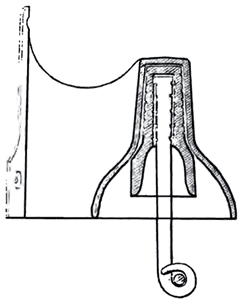[Trade Journal]
Publication: The Journal of the Society of Arts and of the Institutions in Union
London, England
vol. 6, p. 350-351
·
·
Regarding the electric conductor or line-wire, this is either suspended upon poles in the open air, or it is embedded in gutta percha, and interred or submerged. Suspended line-wires generally consists of galvanized or painted iron, of from one-eighth to one-fifth of an inch in diameter, and supported, at intervals of from 50 to 60 yards, from posts by means of insulators. The construction of a really efficient insulator has for many years occupied the serious attention of electrical engineers, for upon it chiefly depends the permanent efficiency of the line. A great variety of insulators have been tried, some of which I am enabled, by the kindness of the Electric Telegraph Company, to present to the meeting. According to continental experience, the insulator of Siemens and Halske (Fig. 1), has been found to combine the desiderata of strength and insulating property in the highest degree. It consists of a cast iron bracket, assuming the form of an inverted bell, with a cylindrical recess at the bottom. A capsule of porcelain is firmly cemented, by means of sulfur mixed with caput mortuum, into the recess, and into this again a stalk of iron is cemented, which, forming a peculiarly twisted loop at the end, supports and secures the line-wire. The insulating property depends upon the dryness of an apron-like extension of the porcelain capsule, which, under the protection of the cast iron bell, is not affected by either rain or dew. Every tenth support is a stretching-post insulator, at which the line-wire is not only supported but held firmly by means of claws, an arrangement which has been found very convenient during the erection of the line-wire, and in case of repairs. An idea of the importance of a good insulator may be formed from the fact, that the cost of finding and repairing a single defect of the line-wire, in a country like Russia, amounts on the average to ₤80.
 |
| Fig. 1 Insulator |
·
·
